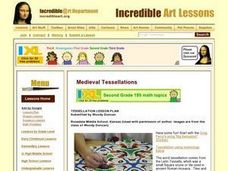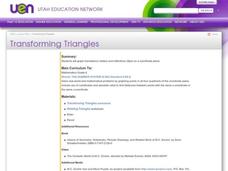Illustrative Mathematics
Regular Tessellations of the Plane
Bringing together the young artists and the young organizers in your class, this lesson plan takes that popular topic of tessellations and gives it algebraic roots. After covering a few basic properties and definitions, learners attack...
Curated OER
Tessellations: Geometric Patterns
Students create tessellation drawings using repeating geometric shapes.
Incredible Art
1, 2, and 3-Point Perspective
Introduce drawing students to perspective with a series of lesson that detail how to draft images in one-, two-, and three-point perspective. Each exercise includes step-by-step, illustrated directions and examples.
National Gallery of Canada
Self-Portrait, Mirrors and Metamorphosis!
Using M.C. Escher's Hand with Reflecting Sphere as inspiration, learners create their own set of self-portraits using various reflective surfaces. The lesson begins with a discussion about portraiture and ends with a presentation of work...
Curated OER
Introducing Tessellations
Students create tessellations to increase their knowledge of the applications of geometry. They explore the different shapes of polygons.
Curated OER
Tessellation Lesson Plan
Students produce original tessellations, using equilateral triangles where three unique symmetrical faces rotate, use shape, pattern/repetition, and color to create a striking composition, and create "beasties" inspired by bestiaries of...
Exploratorium
Exploring Tessellations
Tessellations are patterns of repeating shapes that don't overlap and don't have any gaps. Middle schoolers take this simple definition and engage in a lesson that combines visual art and mathematics. They cut out index cards using...
Curated OER
M. C. Escher - Design - Math Integration
Students create a tessellations using rotation and translation. They also create a tessellation using reflection.
Curated OER
Tesselations
Seventh graders produce a tessellation of an original design developed using an equilateral triangle, where three unique symmetrical faces rotate throughout their creation.
Curated OER
Terrific Tessellations
Students explore tessellations that are found in nature and everyday objects. They observe the works of M.C. Escher. Students create their own tessellations using pencil and paper.
Curated OER
Architecture
Students study tessellations and the work of M.C. Escher. They discuss the terminology of architecture, the historical significance of architecture in different parts of the world, and create their own piece of architecture out of...
Curated OER
Why is this lesson constructivist?
Students formulate a definition of tessellations by comparing and contrasting different patterns and shapes of real objects. They discuss the relatioship between shapes and patterns as well as their function in the real world. Students...
Curated OER
Geometric Transformations
Learners examine images and preimages of a mapping and identify isometry. They view images by M.C. Escher, observe teacher demonstrations, and create a translation image, a rotation image, and a dilation.
Curated OER
Visual Arts: Matisse and Escher
Third graders are introduced to the art of Henri Matisse and M.C. Escher. They create original works in the styles of Matisse and Escher and consider how their innovations have affected modern art.
Curated OER
Symmetry: Theory, Reality and Art!
Students explore the concept of geometric symmetry. For this geometric symmetry lesson, students walk around their school and take pictures of objects that demonstrate symmetry. Students use Microsoft Paint to draw the lines of symmetry...
Creative Educator
Tessellation Sensation
Geometers investigate patterns and symmetry, and examine the artwork of M.C. Escher on the Internet. They compare his style to the floor and ceiling tiles in the classroom. If you have ImageBlender™ software, you could have your class...
Curated OER
Miras, Mirrors, and Kaleidoscopes!
Students use hands-on activities to explore transformations. They view a video segment that demonstrate how M. C. Escher employed geometry and transformations to create so many of his famous drawings.
Curated OER
Let's Tesselate
Students investigate the geometrical concepts of translation, reflection, and rotation. They make different observations looking for the concepts that are displayed in classroom items like floor tiles, carpet designs, and visuals hung in...
Curated OER
Transforming Triangles
Sixth graders graph translations (slides) and reflections (flips) on a coordinate plane. They visualize and identify geometric shapes after applying transformations on a coordinate plane. Finally, 6th graders write a paragraph telling...
Curated OER
Twists and Turns
Pupils reflect, rotate, translate, and dilate figures in the Cartesian coordinate plane using grid paper and dot paper. They use transformations (i.e., reflections, translations, rotations, and dilations) to describe geometric patterns...
Curated OER
Minerals
Students explore the concept of minerals. In this minerals lesson, students discuss how cooling affects the size of crystals. Students discuss how the structure of minerals is a tetrahedron. Students discuss the structure of silicates...
Curated OER
Transforming Triangles
Sixth graders examine how to graph translations (slides) and reflections (flips) on a coordinate plane. They practice the slides and flips kinesthetically and apply it to a worksheet working with triangles.
Curated OER
Batlik- Art of Japan
Eighth graders will examine the use of Japanese ar tforms. The paper lantern is the example drawn from for learners to connect with the culture. The end result is a creative project that should reflect the culture of Japan.
























